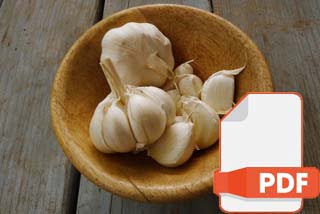Assessment report on Allium sativum L., bulbus

Download - PDF
Introduction
Description of the herbal substance(s), herbal preparation(s) or combinations thereof.The aim of this report is to assess the non-clinical and clinical data available on Allium sativum for preparing a European Union herbal monograph. This report is based on the documentation published in the literature.Herbal substance(s)
Allium sativum L., bulbus
The composition of Allium bulbus is complex. Garlic contains volatile oil (0.1-0.36%), the major components are sulphur compounds like alliin. It contains also proteins (amino acids, glutamyl peptides…), glucides, enzymes (alliinase, peroxidase, myronidase…) Allicin is formed from alliin by the alliinase. It is considered that 1 mg of alliin is equivalent to 0.45 mg of allicin. (Barnes et al., 2002, ESCOP monograph, 2003, Paris et al., 1981)
Relevant constituents of garlic
Organo-sulfur compounds, flavonoids, sapogenins and saponins, selenium compounds and fructosamines have been recognised as the main bioactive principles in raw garlic and different garlic supplements (i.e., garlic powder, garlic oil obtained either with steam distillation or maceration in vegetable oil, different aqueous/alcoholic extracts) (Berginc, 2012).
Organo-sulfur compounds notably alliin and allicin
Evidence from several investigations suggests that the biological and medical functions of garlic are mainly due to their high organo-sulphur compounds content (Omar et al., 2010)
Flavonoids compounds
Apigenin, quercetin, nobiletin, tangeretin, rutin, allixin, myricetin and bergamottin from garlic are good antioxidants with potential cardio-preventive and antioxidants activities. However, their content in raw and processed garlic is very low (Lanzotti V, 2006). Consequently, their effects in the in vivo are expected to be negligible
Sapogenins and saponins
Garlic sapogenins and saponins (proto-eruboside B, eruboside B, proto-iso-eruboside B, iso-eruboside B, sativoside B1-5, R1, R2, β-chlorogenin and others) have been recently identified and their cholesterol-lowering effects in animals and in vitro antifungal, antitumor and cytotoxic activities have been confirmed (Lanzotti V, 2006)The European Pharmacopoeia prescribes no less than 0.45% of allicine (Eur. Ph., 2016)Herbal preparation(s) Powdered herbal substance Dry extract Combinations of herbal substance(s) and/or herbal preparation(s) including a description of vitamin(s) and/or mineral(s) as ingredients of traditional combination herbal medicinal products assessed, where applicable.
Source: https://www.ema.europa.eu/documents/herbal-report/final-assessment-report-allium-sativum-l-bulbus_en.pdf

